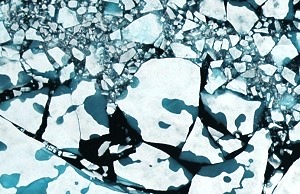How low will it go? New method forecasts Arctic sea ice melt
Release Date 17 June 2014

Arctic sea ice coverage will continue to recover this year from the all-time low of summer 2012, according to experts at the University of Reading.
Polar climate scientists at the University's Department of Meteorology have developed what they say is the most skilful forecasting method yet for predicting the size of the annual summer melt, three months before it hits its September peak.
Using the new method, which analyses the size and coverage of ‘melt ponds' on the surface of the sea ice, the team announced today (June 16) their prediction that the September 2014 sea ice minimum will be 5.4 million km2, close to the level in 2013. The figure is likely to fall within the range 4.9-5.9 million km2.
While this would be higher than the all-time low in 2012 of 3.4 million km2, it would still be 18% below the 1981-2010 average of 6.5 million km2, indicating a continuation of the long-term decline.
Professor Daniel Feltham, who leads the NERC Centre for Polar Observation and Modelling team at the University of Reading, said there had been a relatively low area of melt ponds across the Arctic ice in May - the key factor in the forecast method.
"Compared to the last five years, the Arctic has had colder air temperatures and slightly thicker ice in the relevant areas, meaning the melt ponds have not developed as quickly in 2014," he said.
"Melt ponds are crucial to the speed of the annual ice melt, as the dark water on the surface absorbs more energy from the sun than the white ice, which reflects much of it back into space. But until now, there has not been a physically-based melt pond model."
Different rates of decline of Arctic ice are entirely normal and expected, according to Dr Ed Hawkins, from the National Centre for Atmospheric Science (NCAS) at the University of Reading.
"The latest climate models suggest that Arctic sea ice will dwindle as the 21st century progresses. If greenhouse gas emissions continue to rise at their current rate it's likely that the Arctic Ocean will be completely ice-free in around 40 years' time," Dr Hawkins said.
"However, during this long-term downwards trend we expect to see periods of several years when the sea-ice melts very rapidly, and similar periods of relatively stable ice levels - the decline will not occur smoothly.
"The very low level of Arctic ice in 2012 took many people by surprise. If this new forecast is correct, it may indicate that the decline is temporarily in one of these more stable periods."
The new forecast system could have significant applications, Professor Feltham said.
"This system could be used by the shipping, tourism and oil industries, which are all looking to exploit opportunities that new passages through the Arctic could provide," he said.
"Our work will also help global climate models become more accurate, further strengthening our confidence in how the climate will change in the years and decades ahead."
Today's forecast has been submitted to the Arctic Research Consortium of the United States (ARCUS) Sea Ice Prediction Network, which collates predictions of September sea ice extent from scientists around the world in June every year. However, Professor Feltham says his team's system has been shown in a recent analysis to be of ‘unprecedented skill' compared to all other methods. The analysis was published last month in the journal Nature Climate Change.
Details can be found in Schröder et al (2014), Nature Climate Change.